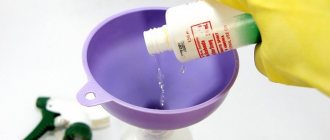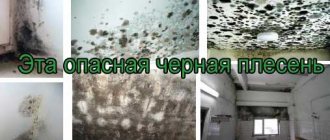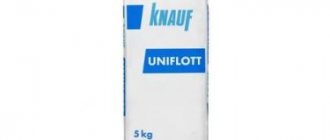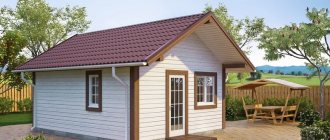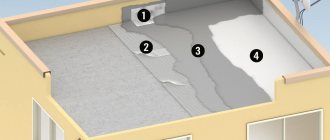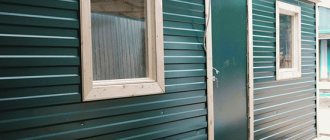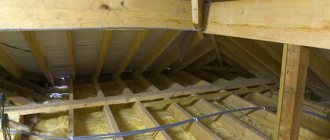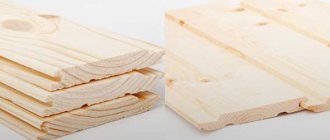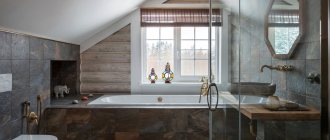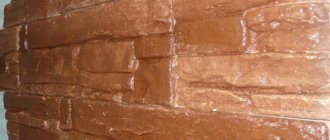Causes of fungus and harm to the body
Unlike fungi that are beneficial to humans, which are used to sour milk and create medicines, there are also harmful types. Mold can settle in industrial premises, in living rooms and bedrooms, in the kitchen, but most often it can be seen in the bathroom or other rooms with high humidity.
The immediate cause of the appearance of fungus lies in dampness. Risk factors:
- indoor humidity more than 60%,
- violation of the ventilation regime, rare ventilation of the room,
- the presence of walls with poor vapor permeability,
- errors during installation of the ventilation system,
- excessive coolness, lack of heating (for example, on the balcony),
- presence of leaking plumbing.
Often the fungus is found in end apartments, where it is colder than in housing with a different location. In some apartments, mold deposits are detected after the installation of plastic windows, since the microclimate in the room changes and air circulation is disrupted.
How to find fungus on walls or ceilings? You need to pay attention to black, green, yellow spots, less often they are gray-brown, pink. Some people think that such stains are just dirt, but you shouldn’t put up with it or remove it with regular water. Mold elements are responsible for the production of aflatoxins, which cause intoxication of the body and over time can provoke cancer.
Yellow mold is considered the most dangerous and poisonous, but other fungi also produce mycotoxins, which reduce immunity and performance and can cause the following diseases:
- rhinitis, otitis, sinusitis,
- allergies, urticaria, diathesis in children,
- bronchial asthma,
- headache,
- damage to the heart and internal organs,
- skin diseases,
- diarrhea, nausea,
- stomatitis,
- conjunctivitis.
The unpleasant sight that is a fungus can be seen almost everywhere where there is high humidity. Microorganisms can invade brick, concrete walls, ceilings or floors; they thrive on putty, plaster and especially wood.
It is the most difficult to remove mold from wood, since the growth rate of microorganisms is faster, and wooden surfaces retain moisture more strongly. Furniture and wooden wall coverings are the most “popular” substrates on which mold settles.
In second place at the risk of infection are loose gypsum walls and bases on which there is a thick layer of putty. Mold also appears on brick and concrete, but removal is easier.
What is mold
Photo: eSovetnik.ru
Mold is living and is formed by a whole colony of single-celled fungus. We can say that mold on the walls is nothing more than moldy fungus.
A huge number of spores of this fungus are constantly in the air. As soon as favorable conditions are created for the growth and development of new life, the spores begin to multiply.
For the rapid development of fungal life to begin, only two conditions are required: warmth and high humidity. Spores can grow anywhere: in paper, cardboard, wood, paint, brick and even concrete.
The moldy fungus forms a large mycelium (or mycelium - the vegetative body of fungi and actinomycetes) and can be seen even without a microscope. It forms large multi-colored spots that appear through the interior decoration of the room.
Mold on walls appears primarily in the corners of the room, near the baseboard, under the wallpaper.
Spores of white house fungus are the most terrible enemies of wood. In one month they can eat 4 cm of oak flooring. In the old days, as soon as such a fungus appeared in a house, the hut was burned to save other buildings.
Rules and conditions for fungus removal
To effectively combat the problem and remove the fungus forever, you need to influence its causes. It is not enough to treat the walls once - a major overhaul will help here. Finishing materials must be removed from the walls, otherwise the fungus will spread further.
Furniture, interior items, belongings, equipment, clothes are removed from the room being repaired, and if possible, everything is disinfected. Textiles and items are washed at a temperature not lower than +60 degrees with powder. Furniture is wiped with antiseptics.
Features of antifungal agents
Basically, these remedies work on the same principle as traditional antifungal remedies. Their action is quite effective. In this case, substances are distinguished by composition:
- Water-soluble inorganic compounds. They mainly contain several types of mineral salts. The significant difference is that the composition has an aggressive effect on metals, but is quickly and easily washed off with water.
- Organic oil based formulations. Such substances are characterized by high toxicity and a persistent unpleasant odor. Used only for external wall treatment. This applies to oils of petroleum and coal origin. Vegetable oils are completely safe for internal use, but are less effective.
- Organic solvents. They are used for external work, as they are active only when interacting with flammable substances: kerosene, drying oil, gasoline.
- Combined substances. May contain all active components from different compositions of antifungal substances.
In addition, compositions are distinguished according to application depending on the type of surface: concrete, brick, plaster and wood. Therefore, you should first decide where the work is being done - inside or outside, and what specific surface will be processed.
Colonies of fungus or mold may appear on a wall made of any finishing material. In many rooms, these reasons are different, but initially it is the reason that is eliminated, and only then removal, cleaning and treatment is carried out. Cleaning of premises differs in the method of influencing problem areas.
Recommendations from experts (3 videos)
Different types of anti-fungus and mold products (33 photos)
Folk remedies for mold
The easiest way to treat walls is to use non-traditional means that are cheap and accessible. It is not recommended to remove large accumulations of fungus using these methods, since they are weaker (with the exception of copper sulfate). After the initial treatment, repeat treatments are done 7–10 days later.
Soda
Mold removal can be done using regular baking soda. This is a universal disinfectant that will not harm humans or pets.
Soda in the amount of a tablespoon should be diluted in a glass of water, then begin to treat the affected areas. The solution is poured into a sprayer, the walls and ceiling are irrigated. After an hour, you need to wash off the soda with water and wipe the base dry with a cloth.
Hydrogen peroxide
The product can be applied to walls in its pure form, without dilution. Peroxide does not produce harmful fumes, and the liquid is not toxic. You just need to be careful with wallpaper, because the solution has bleaching properties and can leave white spots on the surface after drying.
Peroxide can be used together with other components in the following recipe:
- take 4 parts water,
- add 2 parts vinegar, the same amount of boric acid,
- add 3 parts peroxide (3%),
- Apply to the fungus, leave for an hour, rinse.
Vinegar
Using vinegar helps against mold. Table vinegar is poured into a sprayer and the walls or ceiling are irrigated. Then rub with a cloth and leave for 2 hours. Then carefully wash off the vinegar from the surface.
Copper sulfate
Sold in packages in the form of dry powder. About 100 g of vitriol should be poured into a metal bucket, add 10 liters of warm water. Stir the mixture until the powder is completely dissolved. Pour the drug into a spray bottle and treat the affected areas of the apartment. You can use a foam sponge.
The solution should dry for 3 - 5 hours, then it is sprayed again on the same places, and so on up to 2 - 5 times. In advanced cases, you must first remove the putty and finishing material. It is not advisable to stay in the room for 3 days, then the fumes of copper sulfate will stop being released.
Laundry soap
Soap solution is a good antiseptic. Laundry soap is dissolved in water, then the walls are washed in a convenient way. After a couple of hours, wash off the remaining soap with water.
Ammonia
Ammonia can only be used on smooth, hard surfaces, and the product will be useless on porous substrates. Ammonia is mixed with water equally and sprayed onto fungus-damaged areas. Wash off with water after an hour.
Borax
Borax is a non-toxic product of natural origin that has powerful fungicidal properties. Destroys mold and prevents its reappearance.
Before using borax, you need to clean the surface with a vacuum cleaner so that fungal particles do not fly through the air. Then you should prepare the solution, observing the correct proportions.
Take a glass of borax from the bag and dilute it in 2.5 liters of water. The solution is applied to the base with a stiff brush, while simultaneously removing the fungus. The borax should be allowed to dry completely; there is no need to wash it off.
Bleach
Many bleaches contain sodium hypochlorite or other forms of chlorine (eg, Bleach). This additive is very effective against mold and can even replace professional fungicidal preparations.
Bleach is used only on surfaces that are white, otherwise it will not be possible to avoid unsightly stains and damage to the coating. Bleach can be used on tiles and glass, but it is not used on drywall and wood.
Due to its toxicity, working with chlorine must be done with caution. Protect your hands with gloves, and put a respirator on your face. Dilute the drug 1:10 with water and apply to damaged areas using foam rubber or a brush. After complete drying, the surface is cleaned and washed with water.
Other folk recipes
Tea tree oil is a natural antiseptic. Pour a teaspoon of oil into a glass of water and spray the walls and ceiling where the mold has settled. There is no need to rinse off the solution - the product is absolutely harmless to humans.
You can also treat surfaces against fungus using a solution of potassium permanganate. Pour ½ teaspoon of potassium permanganate powder into a liter of water, spray the walls or gently wipe them.
Some people use office glue for mold. It is diluted 1:1 with water, after which small areas with mold can be treated with the product.
General wrestling instructions
Before choosing a remedy for mold on the walls, you should clean the surface of existing stains and affected areas. But first you need to do the following:
- assess the extent of spread and penetration depth of pathogenic pores of fungus and mold;
- identify types of mold and mildew in accordance with color and distribution patterns, that is, patterns;
- completely eliminate the causes of colonies, since further work will be ineffective.
If the surfaces have already begun to become damp, and the extent of the spread is enormous, then the only solution will be aggressive action, namely mechanical work. This work consists of certain stages.
Treatment of walls against fungus and mold consists of the following mechanical effects:
1. Clean the surface of the walls from mold and mildew by removing building material until an undamaged part appears. Particular care should be taken when processing under the wallpaper.
2. If only the top layer is affected, then you can clean the surface using a stiff brush, which has been previously soaked in an antiseptic against mold and mildew. This is the most effective way to clean tiles or paint.
3. Treat the wall using a solution against pathogenic colonies. Most often it is impregnation that is performed.
4. Next, a new layer of building material is applied. To prevent the emergence of new problems of this nature, you need to treat the surface with an anti-fungal agent.
5. The next step is a primer, and then the next layer of solution is applied, which has antiseptic properties.
6. After this, finishing material is laid, which is not exposed to moisture. This is possible in a special room. The principle of removing mold before wallpapering is the same as in any other room.
After this treatment, the fungus disappears completely. By maintaining certain operating conditions of the room, you can get an aesthetically good result. The only problem is money, since such actions correspond to a major overhaul.
Special remedies for fungus
Most manufacturers of building mixtures and paints and varnishes produce various anti-fungal products. It is important to describe the problem to a specialist so that the employee can help you choose a remedy suitable for a specific type of mold. Solutions must match the material to which they will be applied and not spoil it.
The most popular solutions:
- Atlas Mykos - sold in the form of a concentrate, can be used for interior and exterior use, including on mineral surfaces.
- Spectrum - used on wood, putty, painted surfaces, and at high humidity.
- Teflex is an environmentally friendly product that can be applied to walls in a child’s room.
On the walls you can use Antisept, Abedis, Xiolat, Snezhka Impregnation.
Antiseptics in solutions
Typically, solutions are used when the area affected by the fungus is quite large. The drugs are sold in large containers - jars, canisters, and have a ready-to-use form. The concentration of the solutions is safe for humans.
They are applied with a sponge, erasing most of the mold. Usually 1-2 treatments are enough to get rid of the fungus, but then for prevention you can add the product to the water for cleaning the room.
List of the best solutions with fungicidal additives:
- Dali,
- Fongifluid Alpa,
- Olympus Stop mold,
- Biotol,
- Mavix-Bio.
Primers - antifungal
Primers can be used to carry out treatment even at the stage of construction or repair. Good products are sold in any specialized stores; almost every brand of building materials has them. Excellent quality is observed in the soils Milkill (MilKill), Terragrunt, Kremen, Lakra, Auburn.
Most products have the ability to penetrate deeply into the pores of the base. Anti-mold components are introduced into the smallest crevices of concrete, and other substances fill the pores from the outside. To avoid problems with mold for a long time, it is better to treat any surfaces during repairs with similar soils.
Types of fungicidal agents
Most antifungal wall treatments contain fungicides, substances of biological or chemical origin that inhibit the growth of fungi. Active substances are added to various building products and solutions to protect building elements from mold.
In connection with their use, two groups of drugs can be distinguished:
- Basic principles of prevention;
- Concentrated solutions to combat mold.
Emulsions for prevention. The first group of antiseptics is used during repair work - before finishing the walls with mud. Antifungal primers strengthen the substrate, increase adhesion, reduce the porosity of the material, remove mold and prevent further fungal growth.
When choosing an antifungal primer, pay attention to its composition. The emulsion must not contain carbendazim, a toxic fungicide banned in Europe.
The decisive factor when choosing an antifungal and anti-mold primer is the type of surface to be treated:
- strengthening primer – intended for priming and plastering walls for painting or wallpapering;
- universal putty mixture - suitable for various types of surfaces.
- Deep penetration primer - optimal for substrates with low porosity (plasterboard, brick, concrete), as well as for finishing “heavy” coatings, such as tiles;
Mold removal concentrates. Products for treating surfaces affected by fungi. The compositions penetrate the structure of the material and kill mold, lichens and mosses. Many concentrated products work for a long time and prevent re-infection.
Fungicidal emulsions are available on the market for both universal use and for specific substrates (wood, stone, concrete). Drugs with a narrowly targeted effect are more effective
Emulsions for the prevention and removal of fungi are developed based on various binders:
- Latex - does not contain heavy metal salts, so the product is recommended for painting walls in residential premises. Breathability is an added benefit.
- Acrylic – alkyd products can be used both indoors and outdoors.
- Alkyd emulsions are often used to paint wood substrates.
Primers and concentrates are ready-to-use liquids. The concentrated emulsion can be diluted with water to prevent fungal growth.
Safety precautions when working
When processing the premises, it is worth using personal protective equipment - rubber gloves, cotton-gauze bandages or pharmaceutical masks, respirators. It is better to wear glasses on your eyes when using caustic solutions. It is recommended to carry out all work wearing thick protective clothing.
After finishing the treatment of the walls, you need to thoroughly ventilate the room, wash the clothes, and throw away the rags and sponges, packing them in a bag. If allergies, nausea, or vomiting occur, you should consult a doctor - this may be a sign of intoxication.
When does mold appear on the walls in apartments?
Fungal spores that form mold colonies are present in most residential premises, but visible deposits on wall surfaces appear where the spores not only settle on the surface, but also receive conditions for the development of colonies.
The main factors for the development of mold are:
- Insufficient ventilation of the room with constant air circulation;
- Increased humidity and air temperature;
- Fungal infection of wooden structural elements of a building;
- Freezing of the external walls of the building and the presence of cold “bridges” in the structure of the walls and ceilings;
- Unsanitary conditions of the premises.
The presence of even one of the listed conditions increases the risk of mold damage to the walls of the room.
The process of removing mold from damaged areas
At the first stage, it is important to identify why the fungus has settled in the room. This will help address risk factors and prevent problems from occurring in the future.
It is necessary to thoroughly inspect the affected area of the wall for the presence of voids between the plaster and the base. By tapping the wall with a hammer, you can quickly identify places where the plaster has separated by the dull sound. Such areas must be repaired by removing the entire area, otherwise the mold will take up residence in its original location.
Fungus Removal Tools
To get rid of the problem, you need to prepare in advance rags, a basin and bucket, a brush, a roller, a sprayer, personal protective equipment and a solution with a fungicidal effect.
A metal spatula will be needed to remove the affected plaster. You need water to moisten the affected area so that fungal spores do not spread indoors by air.
Working in the bathroom
The most vulnerable areas in the bathroom are the joints between the plumbing fixtures and the walls, which are usually treated with sealant. Mold most often settles in the seams between slabs, in the area of socket boxes. If there is an indelible black coating there, it is most likely a fungus.
Work order:
- Remove moldy sealant or other material on which fungus has settled.
- Treat the area with the selected product.
- After drying, reapply sealant or other polymer.
- If fungus affects the seams between the tiles, scrape it off with a metal spatula or scraper.
- Apply grout with added fungicides.
It happens that mold settles in the bathroom ceiling. Then you will have to moisten the area with water, leave it for an hour, then scrape off the plaster with fungus. Next, you need to putty and prime the area with a special product with anti-mold additives. As it dries, apply another layer of soil that has the ability to penetrate deeply. Then the ceiling can be sanded and painted.
Removing fungus on walls and wallpaper
If fungus is noticed on the wall in the apartment, it must be removed without delay - within six months the mold will “grow” to the concrete base. The damaged finish must be removed by first sprinkling with water, and all deposits must be thoroughly cleaned. After drying the wall, it is treated with a fungicidal agent.
Drywall and wood should be treated with the strongest means, because the fungus spreads very quickly and penetrates deeply.
Mold spreads across the wallpaper at lightning speed, so you will have to remove the entire strip or even several. After removing the wallpaper, you need to check whether the affected layer covers plaster, concrete or brick. It may be necessary to carry out a major renovation by completely removing the trim.
Working against fungus on wood
There are special impregnations for wood, which contain antiseptic and fungicidal additives. Anti-fungal agents are applied to a dry surface from which areas of mold have already been manually removed.
Impregnation should be applied at least 3 times, and each layer should be allowed to dry. To complete the work, apply a layer of primer suitable for wooden surfaces.
How to remove fungus from walls
Before removing fungus from the walls, understand the reason for its appearance. This way you can choose the most optimal way to eliminate the fungus and prevent its reappearance.
Special chemicals will help you remove the fungus, of which primer is a fairly popular remedy. It is well suited for concrete surfaces and brick. If fungus appears in the toilet or shower, you can safely use an antifungal primer - it is suitable for wet rooms and, in addition to fungus, also fights microbes.
When purchasing a primer to combat fungus, do not apply it directly to the walls. Please read the instructions carefully first!
In addition to primer, you can use simple bleach. It works well on tiles and glass. Bleach can be used to treat not only walls, but also ceilings and floors. But be sure to check the specifics of working with this substance to avoid trouble.
Prevention measures
The best prevention of fungus is to maintain cleanliness and prevent dampness. Ventilation valves must be installed on double-glazed windows, and ventilation must be installed in bathrooms and kitchens. It is important to insulate freezing walls, and in a private house to build a strong foundation and blind area. You need to check the plumbing: there are no leaks or breakdowns, otherwise fungus will inevitably settle in the bathroom.
If the air is too humid, uniform heating and installing an air conditioner to dry the air help. Reduces the risk of mold by drying clothes on the balcony rather than in the apartment, regularly using a kitchen hood, and frequently washing areas where mold may appear with antiseptic agents.
Spoiled aesthetics and more
Dark spots of fungus will appear in the future on the wallpaper.
Penetrating deep into building materials, they begin their destructive activity. Dark spots on the wallpaper, gray-green stains on the walls, an unpleasant slimy or shaggy surface of the affected areas are unlikely to add aesthetics to your interior.
At the same time, being in the vicinity of such representatives also does not bode well for the health of the apartment’s inhabitants - allergies, asthma and other diseases can be caused by these tiny living organisms.
Their distinctive feature is their reproduction by spores. Spreading with dust throughout the house, these spores fill all its corners. Once on the skin, mucous membranes or in the respiratory tract, they become a source of allergens and toxins.
As a result, after mold and mildew appear in a house, all its inhabitants may sooner or later become patients of an allergist, dermatologist or ENT specialist.
Cleaning contaminated walls
Without destroying the wall finishing, the fungus can be removed at the initial stage of its development, when there are less than 10 scattered spots up to 1 cm in size on the surface. These are individual spores that have sprouted. The roots did not pierce the plaster with their roots, and did not unite into a mycelium. Any store-bought antifungal agent for walls, a solution of chlorine, vinegar and soda, is suitable for treatment.
At the initial stage of damage, mold is rarely detected. Usually there are many spots, they are larger than 2 cm and are located in a whole colony. The roots have penetrated the entire mass of plaster and it must be removed, taking safety measures.
- Wear goggles, a respirator, and rubber gloves.
- Clothes must have long sleeves. Fungal spores are small and can penetrate the skin, causing itching and irritation.
- If the walls are covered with wallpaper, remove them.
- Before removing the plaster, wet the wall. There will be less dust when removing the putty. It’s good to spray it with bleach diluted in half with water a day before and a solution of 9% vinegar. The growth of mushrooms will slow down, some will die, and the spores will be several times smaller.
- The wall is stripped down to masonry or clean concrete. Remove the remaining solution with a wire brush.
If the mycelium has not grown all the way through, there is no need to clean it further. This happens if several small areas of mold stains have not united into one, the fungus has settled relatively recently.
After treatment with fungicides, the wall is plastered and puttied. It is necessary to use materials with antifungal agents. They are more expensive than conventional building mixtures, but will not allow the fungus to settle again. Sold ready-made, packaged in plastic buckets. If the cleaning was not deep, you can get by with a deep penetration antibacterial primer. This product must be added when finishing wooden walls.
Each layer of plaster and putty must dry before the next one is applied. Before wallpapering and painting, you need to cover the entire area with an antifungal primer, repeat it a day later, and only after complete drying - after 36 hours, you can apply paint and glue the wallpaper.
Why is mold dangerous for humans and their health?
2 ways to interact with a person:
- direct contact with skin
- entry into the body
The fungus that enters the body with spoiled food is also very harmful. This is the topic of another article, but still - be careful and take care of yourself!
Since the direct reproduction of mold is carried out by spores, that is, seeds, they float in the air. They can remain suspended in the room for a long time. Therefore, the greatest harm lies in the fact that people and pets inhale these spores.
They are toxic!
Once in the lungs, the seeds are spread throughout the body, poisoning it. Doctors have proven that constant inhalation of the fungus causes a huge number of pathologies:
- allergies;
- skin diseases;
- articular;
- gastrointestinal tract;
- upper respiratory tract diseases;
- general malaise;
- nausea;
- headache;
- kidney damage;
- internal bleeding.
Children are most susceptible to negative impacts. Since their immunity has not yet developed enough to withstand the scourge. Elderly people are also at risk.
What is the danger of fungus?
Not everyone knows what mold is and the harm it can cause to health. The fungus damages walls and cladding. The moldy fungus develops in colonies that destroy the wallpaper, the structure of the plaster as a result the walls turn black and begin to crack over time. If a fungus gets into a crack, it begins to attack the wall from the inside and then it will be almost impossible to overcome it.
The second negative aspect is the effect on the human body. Spores can enter through the respiratory system and remain inside until a suitable situation for their development is formed, for example, a decrease in immunity.
In rooms where fungus and mold appear there is often an unpleasant damp smell
Pathogenic microflora causes a number of diseases and symptoms:
- mycoses, dermatoses - fungal skin lesions
- dizziness, nausea, headaches
- vomiting, heartburn, bowel dysfunction
- pathologies of the musculoskeletal system
If you breathe in the fungus for a long time, chronic diseases of the cardiovascular system, kidneys, and liver develop.
